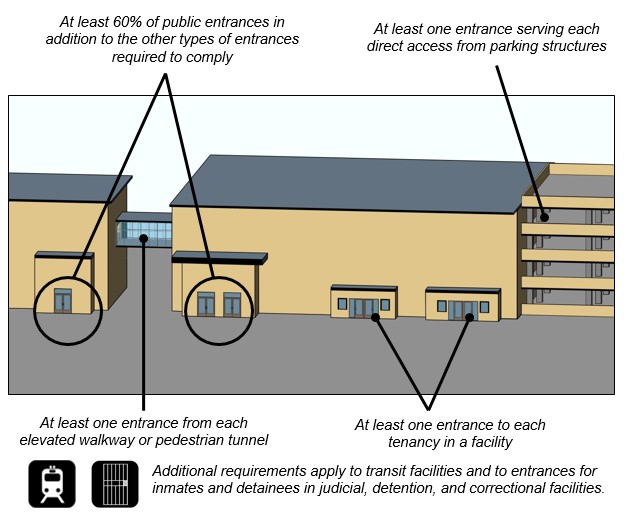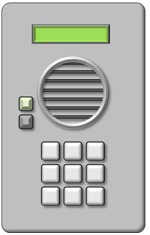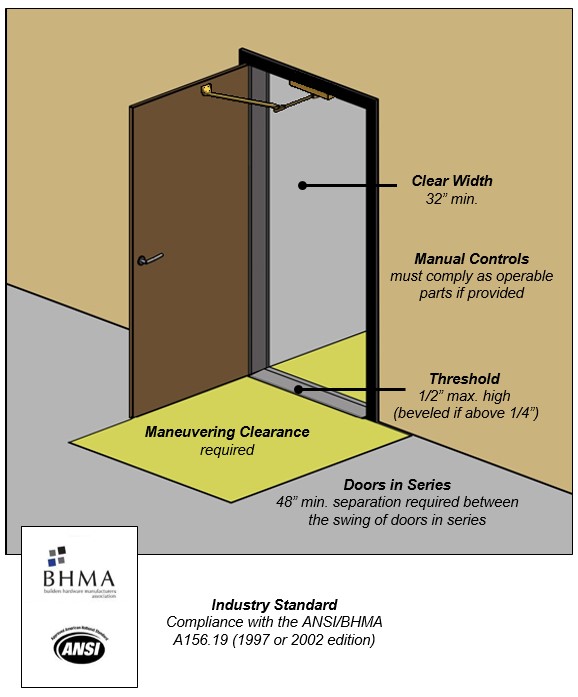Controlling Doors And Other Entrances
This guide explains scoping and technical requirements for accessible entrances, doors and gates in the ADA Standards.
Notational tips for users of screen reading software follow. In this document ″ indicates inches and ′ indicates feet. Some images are paired with visually hidden notes.  These annotations are prefaced with begin and finish prototype notes.
Attainable Entrances: Minimum Number
[§206.4]
At least 60% of public entrances must be attainable in new construction, in addition to entrances directly serving tenancies, parking facilities, pedestrian tunnels and elevated walkways. "Public entrances" include all entrances except those that are restricted or that are used exclusively equally service entrances.
Public Entrances Required to exist Attainable

Components of Accessible Entrances

Entrance Landings
Archway landings must accommodate door maneuvering clearances as well as landings for provided ramps.

Security Barriers
[§206.viii]
Security bollards and screening devices at accessible entrances cannot obstruct accessible routes or attainable means of egress. Accessible routes can be next to metal detectors and other screening devices that do not accommodate all people with disabilities, but the route must be located and so users tin maintain an equivalent level of visual contact with personal items.
 Accessible route adjacent to security screening device
Accessible route adjacent to security screening device
Restricted Entrances
[§206.4.vii]
If entrances are restricted to sure occupants on a controlled basis, at least one must comply in add-on to public entrances required to exist accessible. This applies to those entrances where entry access is verified by security personnel and is strictly limited to certain occupants, simply no one else, including guests or companions of authorized individuals. All other types of entrances, excluding service entrances, are considered "public entrances" under the Standards, including employee-only entrances requiring keys or admission cards or codes but that lack the level of security of restricted entrances.

Two-Way Communication Systems
[§230] and [§708] Where two-fashion communication systems are provided to gain entry to a facility or to restricted spaces, they must include visual and audible signals to accommodate people with hearing, speech, or visual impairments. This applies to all entrances equipped with such systems, including those that are inaccessible. Lighted signals should have labels to indicate their significant. If handsets are provided, cords must be at least 29″ long. Control buttons and other operable parts must comply at those systems located at accessible entrances.
Alterations
[§206.4]
In alterations to existing facilities, accessible entrances are required:
- if an existing entrance is contradistinct (and no fully compliant entrance already exists);
- when entrances are newly added to a facility or as role of a facility improver; or
- equally necessary to attain an accessible path of travel to primary function areas that are altered (unless disproportionate to the toll).
When alterations are fabricated to principal function areas, a connecting attainable path of travel from site arrival points is required to the extent that it does not exceed more than than 20% of the project cost. Achieving an accessible archway should be the elevation priority in providing the accessible path of travel according to regulations implementing these Standards.
Qualified Historic Facilities
These requirements also utilize when alterations are fabricated to qualified celebrated facilities. However, if making a public entrance accessible would threaten or destroy a facility'southward celebrated significance (as adamant by the appropriate State Celebrated Preservation Official or Informational Council on Celebrated Preservation), admission can be provided to a not-public entrance instead. A notification or remote monitoring system is required where such an entrance is locked. (§206.4, Ex. two)

Doors, Doorways and Gates
[§206.five]
Compliance is required for doors, doorways, and gates providing user passage on accessible routes. At least one accessible door, doorway, or gate serving each accessible room, infinite, and entrance must comply.
Transmission Doors and Gates
[§404.2

Clear Width
[§404.2.3]

The clear width is measured from the stop to the face up of doors or gates open 90⁰ (or to the leading border of sliding or folding doors. No project into the clear width is permitted beneath 34″.
Clear Width and Vertical Clearance of Doors and Gates
[§404.two.three]

Maneuvering Clearances
[§404.2.4]
Required maneuvering clearances provide space for opening and proceeding through doors, doorways, and gates using wheelchairs and other mobility aids.
 Required door clearances provide unobstructed infinite for maneuvering through doorways.
Required door clearances provide unobstructed infinite for maneuvering through doorways.
 Maneuvering clearances must be free of protrusions the total height (eighty″ minimum) and changes in level (other than thresholds).
Maneuvering clearances must be free of protrusions the total height (eighty″ minimum) and changes in level (other than thresholds).

Maneuvering clearances are specified according to direction of approach, swing of doors, and in some cases the presence of a closer or latch. They are required on both sides of doors or gates except at those that can be used in one direction merely.

Clearance beyond the latch side is not required at entry doors to hospital patient rooms. Such doors are commonly wider to accommodate beds and gurneys, and they are often located shut to adjacent interior walls to facilitate circulation and to enhance privacy.
Recessed Doors and Gates
[§404.2.4.3]

Thick walls, casework, shelving, columns and other elements can cause doors or gates to exist recessed. If whatsoever obstruction inside xviii″ of the latch side projects more than than 8″ from the face of a door or gate, maneuvering clearances for a frontward approach must be provided. This infinite must exist inset at obstructions so that information technology is no more than than 8″ from the face up of the door or gate.
 Walls and other obstructions can offset the maneuvering clearance upwards to 8″ from the face of the door.
Walls and other obstructions can offset the maneuvering clearance upwards to 8″ from the face of the door.
 At deeper recesses, the maneuvering clearance must be sized for a forward arroyo and located eight″ maximum from the face of the door.
At deeper recesses, the maneuvering clearance must be sized for a forward arroyo and located eight″ maximum from the face of the door.
Thresholds
[§404.2.five]

The meridian of thresholds is express to 1/2″ in new structure. The border must exist beveled 1:2 maximum above a height of 1/4″. A maximum peak of 3/4″ is permitted for existing or altered thresholds if they have a beveled edge on each side with a slope non steeper than 1:2. These requirements utilise to all types of doors required to comply, including sliding doors.
Threshold Contour

Doors and Gates in Series
[§404.2.vi]
At hinged or pivoted doors or gates in series, a separation is required that is at to the lowest degree 48″ plus the width of doors or gates swinging into the space. This allows users to articulate one door or gate before opening the next and applies to those doors or gates that are opposite each other where travel through both doors is required.



Recommendation: Wheelchair space xxx″ minimum by 48″ minimum across the swing of a door in other configurations, such equally vestibules with doors on next walls, will provide room to clear one door earlier opening the next.
Door and Gate Hardware
[§404.ii.7]

Door and gate hardware must:
- allow one-manus operation
- not require tight grasping, pinching, or twisting of the wrist
- operate with 5 lbf maximum
- exist located 34″ to 48″ higher up the floor or footing.
Hardware that tin can exist operated with a loose grip or airtight fist, such as lever-shaped handles and U-shaped pulls, accommodates the greatest range of users. (Closed-fist operation, while appropriate, is non mandated by the Standards). Circular door knobs do non comply because they crave twisting of the wrist.
Latches and locks with small parts that must be manipulated tin be difficult to utilise and volition non comply if pinching is necessary. Yet, keys and admission cards that are not part of the lockset are not required to comply (but those that exercise not require pinching or turning provide meliorate access). Hardware that does not require simultaneous actions are amend, just some types, such as handles with thumb latches are acceptable.
Opening Forcefulness
[§404.2.9]
The maximum 5 lbf opening force applies to all attainable doors and gates except:
- fire doors (minimum opening force allowed by lawmaking)
- exterior hinged doors (no maximum specified)
- latch bolts and other devices that continue doors or gates closed
The v lbf maximum applies to the continuous application of forcefulness necessary to fully open a door, non the initial force needed to overcome the door's seal resulting from unequal pressure. Latch bolts must be retracted and other devices that continue doors or gates closed must be disengaged prior to measuring the opening force. (Such devices, like other door and gate hardware, must operate with a maximum five lbf force (§404.2.7), but their operating strength is non included in the measure of door or gate opening force). Door pressure gauges and other products are available to measure the opening force.
Measuring Door or Gate Opening Force with Pressure Estimate
When using door gauges and other measuring devices, it is appropriate to follow these steps (except where production instructions specify otherwise):
- Open up the door and then that the face edge aligns with the door frame outside border
- Place judge immediately above door operating hardware about ii½″ from the latch edge of the door (approximately the centerline of the door hardware)
- Button slowly keeping the pressure approximate perpendicular to the confront of the door
- Remove the pressure gauge when the door is open up 70 degrees.
Opening Force of Exterior Doors

The opening force of outside swing doors is impacted by wind loading and other exterior atmospheric condition, gasketing, HVAC systems, energy efficiency, and the weight of doors. The minimum force needed to ensure proper closure and positive latch normally exceeds the accessible limit of 5 pounds of forcefulness (lbf) required at other doors. For this reason, a maximum opening force is not specified for exterior hinged doors.
Door and Gate Surfaces
[§404.2.10]

The bottom surface of doors and gates on the push button side must be smooth to a tiptop of at least x″. This facilitates admission since mobility aids, including wheelchair footrests, are sometimes used to push or prop open doors. Kicking plates can be used to aid protect door surfaces, just any gaps or cavities betwixt the kick plate and the door surface must exist airtight or capped. Horizontal or vertical joints in this surface cannot exceed a 1/16″ variation in aeroplane.
These requirements do not apply to:
- Sliding doors
- Doors and gates that practise not extend to within x″ of the finish floor or ground
- Existing doors or gates with kick plates (so long every bit cavities created past kick plates are capped)
- Tempered glass doors without stiles if the top border of the bottom track or shoe is tapered at least 60⁰ from the horizontal.

Communication Access at Doors
[§806.3.2]
In addition to requirements for ii-mode communication systems provided at restricted entrances, the Standards include requirements for communication access in transient lodging and residential facilities:

- visible signals for door bells or knocks are required in transient lodging invitee rooms providing advice access (§806.three.2);
- a difficult-wired doorbell with visible signals is required at the master entrance in dwelling units providing communication access, along with a means to visually place visitors without opening the door, such every bit a vision panel or peephole (§809.5.5).
Doors and Gates Operated Only Past Security Personnel
[§404.1, Ex]

Manual doors, doorways, and gates that are designed to be operated merely past security personnel, such as guards in a jail or prison, are exempt from requirements for hardware, endmost speed, and opening force, but must encounter all other requirements, including those for maneuvering clearance. This exception applies simply where security personnel have sole command of doors or gates. If automatic, such doors or gates are required to comply only with provisions for clear width and thresholds, also every bit applicable provisions of the referenced ANSI/BHMA Standards.
Automatic and Power-Assisted Doors and Gates
[§404.3]

Doors are not required to be automated, but must comply when provided. The Standards apply industry Standards developed under protocols of the American National Standards Establish (ANSI) and published by the Builders Hardware Manufacturers Clan (BHMA). The ANSI/BHMA Standards address operating characteristics, including opening speed, rubber features, sensors and activation devices, and labeling, among others. Doors are classified by their type or level of automation.
Power-Assisted Doors and Gates
[§404.three]
Power-assisted devices reduce the opening strength of doors with endmost mechanisms.They are activated past initial manual force, switches, or sensors. Almost reduce, but do not fully eliminate, the manual force needed to open up a door. For this reason, they must meet maneuvering clearance requirements.
Power-Assisted Door

Depression Energy Doors and Gates
[§404.3
Depression free energy doors and gates usually crave activation by the user through a push plate or command and are often used in moderate traffic locations as an culling to manual operation. Most part like a transmission type but with a powered opener and closer option.
Automatic Door (Low Energy)

Controls
[§404.3.v]
Door and gate controls must be compliant as operable parts (operable with one hand and without tight grasping, pinching, twisting of the wrist, or more than 5 lbf). Articulate floor infinite at controls must exist located exterior the door swing to prevent users from getting hitting by the door.

Clear floor space at door control must be located outside door swing.

Full-Powered Automated Doors and Gates
[§404.3]
Full-powered automated doors and gates are often plant in grocery and retail stores, hotels, and airports to ease passage with shopping carts or luggage. Virtually are automatically activated by mats or overhead sensors and do not require manual activation by users.
Automated Door (Total-Powered)

Common Questions

Must a principal archway be accessible?
The Standards require that primary entrances to home units be accessible. It is advisable, though not required, that access be provided to the principal entrances of other types of facilities.
Is there a maximum travel distance to entrances from parking and other site inflow points?
No, the Standards do not limit the travel distance to accessible entrances. Accessible parking spaces must be located on the shortest accessible route to an accessible archway (relative to other spaces in the parking facility). A quantitative travel altitude between entrances and site inflow points is not specified. In addition, accessible routes must coincide with, or be located in the same area as, general circulation paths.
Is automation of doors required?
Automation of doors is not required by the Standards, merely it is highly recommended for entrance doors where the opening forcefulness is pregnant. A maximum opening force is not specified for exterior hinged doors because of the closing strength typically necessary for ensuring positive latch against air current loading, air pressure, and other conditions. This often results in opening forces well above the 5 lbf maximum. Difficulty opening exterior swing doors is a common complaint. Automation offers the best solution. Otherwise, closers should exist fix with the minimum force practicable.
Do requirements for "public entrances" apply simply to those entrances used by the public?
No, scoping provisions for accessible public entrances are not limited to those used by the public. The term "public entrance" applies to all entrances other than service or restricted entrances. "Restricted entrances" are those available for common use (but non public use) on a controlled basis. This is intended to apply specifically to entrances where user identity is verified and entry is strictly limited to certain occupants, merely no 1 else, including guests or companions of authorized individuals. Other types of entrances with lower levels of security, including employee-only entrances requiring keys, keypads, or admission cards, are considered "public entrances."
Are employee entrances required to be accessible?
Where employee entrances meeting the definition of a "restricted archway" are provided, at least one must be accessible. Other types of employee entrances must be accessible as "public entrances." In facilities with separate company and employee entrances, access should be dispersed so that accessible entrances serve both types of traffic.
Are closet doors and pantry doors required to comply?
Requirements for doors, doorways, and gates in §404 employ to those that provide "user passage" (§206.five). Doors serving walk-in closets or pantries must comply. Doors to shallow closets or pantries, cabinets and other storage elements non providing user passage do non accept to comply with provisions for doors, but must run across requirements for storage (§811), including those for clear floor infinite and operable parts.
Is compliance on both sides of a door or gate required when information technology is usable only from ane side?
No, compliance is not required on both sides of those doors or gates that can exist used in 1 management just. Compliance is required but on the usable side. Examples include exit-simply doors with no operating hardware on the outside side or separate enter and go out fare gates in transit stations. However, if a door or gate is usable in both directions, fifty-fifty occasionally, such as go out-simply doors that may automatically unlock in emergencies to be usable from both directions, then compliance on both sides is required.
Tin can handrails or other elements overlap door maneuvering clearances?
No, door maneuvering clearances must be costless of whatsoever overlapping objects, even those providing articulatio genus and toe clearance, which can interfere with maneuvering at doors and doorways. Even so, door maneuvering clearances can exist offset up to viii″ from the face of the door or gate to adapt wall thickness, casework, shelves, or other elements adjacent to doorways, including handrails. The door maneuvering clearance must be measured from the leading edge of such elements so that the total clearance is gratuitous of any obstruction.
Is latch-side maneuvering clearance equally specified in the Standards applicable to doors with panic bars?
When latch-side clearance is required as office of the maneuvering clearances specified for a door, including on the push side of doors with a forward arroyo that take both a closer and latch, it must exist provided at transmission doors with panic bars too. Latch-side clearance not but provides proper positioning at door hardware just also facilitates proceeding through doors against the force of closers.
Are locks operated past keys prohibited due to the pinching or twisting of the wrist their operation typically requires?
No, non-fixed portions of door or gate hardware, including keys and access cards, are not covered by the Standards, merely those that tin can be used without pinching or turning will provide easier access. Not-fixed portions tin be modified or adjusted as needed for accessibility.
Are jump hinges and gravity hinges considered "closers" in determining the size of maneuvering clearances?
No. Some approaches crave additional maneuvering clearances when a door or gate is equipped with a closer because of the boosted force that must be counteracted in proceeding through doors. Since bound and gravity hinges do not significantly bear on the opening force of doors, they are not considered "closers" for purposes of specifying door maneuvering clearance.
Tin can maneuvering for a forward approach be provided when there is space at least 60″ deep in front end of a door?
Space at least threescore″ deep in front of a door that is unobstructed on approach sides will provide sufficient depth for a forward approach if appropriate strike-side clearance is provided; just in the case of pull-side/ hinge-side approaches, greater latch-side clearance (36″ minimum) is all the same required because the minimum depth for this clearance is sixty″ (54″ if the latch-side clearance is at least 42″).
 Infinite at least lx″ deep in front of a door will adapt a forward arroyo, except in instance of hinge approaches on the pull side.
Infinite at least lx″ deep in front of a door will adapt a forward arroyo, except in instance of hinge approaches on the pull side.
 On the pull side of hinge approaches, 36″ minimum latch-side clearance is required if the depth is 60″ minimum (The depth can exist 54″ minimum if the latch-side clearance is at least 42″.)
On the pull side of hinge approaches, 36″ minimum latch-side clearance is required if the depth is 60″ minimum (The depth can exist 54″ minimum if the latch-side clearance is at least 42″.)
Is boosted latch side clearance required on the button side of doors with a forward approach when either a latch or closer (but not both) is provided?
No, latch clearance 12″ minimum is required for forwards approaches on the push-side of doors equipped with both a closer and a latch. If a door has a closer but no latch, or a latch and no closer, no additional latch side clearance is required (although providing the clearance is helpful in maneuvering through doors with closers without latches). This is also true for the additional depth required for hinge approaches on the button side when both a closer and latch is provided. For latch approaches, additional clearance is required on the push side and the pull side when simply a closer is provided.
Are screen doors or storm doors considered "doors in serial"?
No, screen or storm doors are not considered "doors in series" since they are part of the same doorway opening equally the entry door. They are non prohibited by the Standards only must come across all applicable requirements for doors except those pertaining to doors in series.
If a more than recent edition of ANSI/BHMA Standards for automatic doors is issued should that be followed instead of those referenced?
The specific editions of the ANSI/BHMA Standards referenced by the Standards are to be followed (although the Admission Board intends to update references to keep them electric current). Compliance with a later edition may be possible nether the provision for "equivalent facilitation" (§103) if information technology is comparable to, or stricter than, the referenced editions.
Controlling Doors And Other Entrances,
Source: https://www.access-board.gov/ada/guides/chapter-4-entrances-doors-and-gates/
Posted by: scottgasked.blogspot.com


0 Response to "Controlling Doors And Other Entrances"
Post a Comment